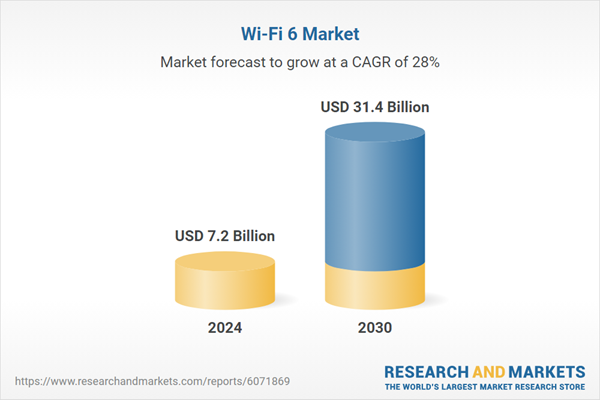Global Wi-Fi 6 Market - Key Trends & Drivers Summarized
Why Is Wi-Fi 6 Transforming Wireless Connectivity Across Industries?
Wi-Fi 6, also known as 802.11ax, is revolutionizing wireless networking by delivering faster speeds, increased capacity, and improved efficiency in high-density environments. As the demand for seamless and high-performance internet connectivity continues to grow, businesses, households, and public infrastructure are upgrading to Wi-Fi 6 to support modern digital applications. The proliferation of smart homes, IoT devices, cloud computing, and high-bandwidth applications such as 4K/8K streaming and online gaming has driven the need for more advanced wireless solutions. Unlike previous generations, Wi-Fi 6 employs technologies like Orthogonal Frequency Division Multiple Access (OFDMA) and Target Wake Time (TWT) to enhance network efficiency, reduce latency, and extend battery life for connected devices. In enterprise and public settings, Wi-Fi 6 enables better connectivity in crowded environments such as stadiums, airports, and offices, where multiple users require stable and fast internet access. As digital transformation accelerates across industries, Wi-Fi 6 is emerging as a key enabler of next-generation connectivity.How Are AI, 5G, and Edge Computing Enhancing the Capabilities of Wi-Fi 6?
The integration of artificial intelligence (AI), 5G, and edge computing with Wi-Fi 6 is further enhancing its capabilities and enabling more intelligent and adaptive networking solutions. AI-driven network management systems are being deployed to optimize Wi-Fi 6 performance by dynamically adjusting bandwidth allocation, detecting congestion, and predicting network failures. This ensures a seamless user experience and enhances security through real-time threat detection. The coexistence of Wi-Fi 6 and 5G is also a game-changer, as hybrid networking solutions leverage the strengths of both technologies to deliver ultra-reliable, high-speed connectivity in enterprise and industrial applications. Additionally, edge computing enables faster data processing at the network edge, reducing latency for applications such as real-time analytics, autonomous vehicles, and augmented reality (AR). As AI-powered automation and 5G connectivity expand, Wi-Fi 6 is expected to become an integral component of future digital ecosystems, bridging the gap between wireless and cellular networking solutions.What Challenges Are Impacting the Widespread Adoption of Wi-Fi 6?
Despite its advantages, the widespread adoption of Wi-Fi 6 faces challenges related to infrastructure upgrades, device compatibility, and deployment costs. Many existing networks still operate on older Wi-Fi standards, requiring businesses and consumers to invest in new routers, access points, and compatible devices to fully utilize Wi-Fi 6 capabilities. The transition can be costly, particularly for large enterprises that require extensive infrastructure upgrades. Additionally, while Wi-Fi 6 is backward compatible with previous Wi-Fi generations, older devices may not fully benefit from its advanced features, limiting the overall user experience. The need for proper network planning and optimization also poses a challenge, as deploying Wi-Fi 6 in complex environments requires expertise in network design and traffic management. Addressing these challenges requires continued investment in education, cost-effective deployment strategies, and widespread availability of Wi-Fi 6-compatible devices to accelerate market penetration.What Factors Are Driving the Growth of the Wi-Fi 6 Market?
The growth in the Wi-Fi 6 market is driven by several factors, including the increasing adoption of smart devices, the expansion of enterprise digital transformation initiatives, and rising demand for high-speed, low-latency connectivity. The surge in remote work, online education, and virtual collaboration has heightened the need for robust wireless networks that can handle multiple connected devices without compromising performance. The expansion of smart cities and IoT deployments has also contributed to Wi-Fi 6 adoption, as the technology enables efficient data transmission for connected infrastructure, including smart grids, surveillance systems, and public transportation networks. Additionally, the demand for seamless streaming, gaming, and real-time cloud applications has propelled the need for Wi-Fi 6-enabled home and commercial networks. As more businesses and consumers recognize the benefits of Wi-Fi 6 in enhancing network efficiency and user experience, its adoption is expected to accelerate, shaping the future of wireless communication.Report Scope
The report analyzes the Wi-Fi 6 market, presented in terms of market value (US$). The analysis covers the key segments and geographic regions outlined below:- Segments: Offering (Wi-Fi 6 Hardware, Wi-Fi 6 Solution, Wi-Fi 6 Services); Location Type (Outdoor Location, Indoor Location); Application (Immersive Technologies, HD Video Streaming & Video Streaming, Smart Home Devices, IoT & Industry 4.0, Telemedicine, Other Applications); Vertical (Retail & Ecommerce Vertical, Education Vertical, Government & Public Sector Vertical, Manufacturing Vertical, Media & Entertainment Vertical, Healthcare & Life Sciences Vertical, Transportation & Logistics Vertical, Travel & Hospitality Vertical, Other Verticals).
- Geographic Regions/Countries: World; United States; Canada; Japan; China; Europe (France; Germany; Italy; United Kingdom; Spain; Russia; and Rest of Europe); Asia-Pacific (Australia; India; South Korea; and Rest of Asia-Pacific); Latin America (Argentina; Brazil; Mexico; and Rest of Latin America); Middle East (Iran; Israel; Saudi Arabia; United Arab Emirates; and Rest of Middle East); and Africa.
Some of the 34 companies featured in this Wi-Fi 6 market report include -
- Alcatel-Lucent Enterprise
- Aruba Networks (HPE)
- AT&T Inc.
- Broadcom Inc.
- Cambium Networks
- Cisco Systems Inc.
- D-Link Corporation
- Extreme Networks Inc.
- Fortinet Inc.
- H3C Technologies Co., Ltd.
- Huawei Technologies Co., Ltd.
- Intel Corporation
- Juniper Networks Inc.
- Keysight Technologies
- LitePoint Corporation
- MediaTek Inc.
- Murata Manufacturing Co., Ltd.
- NETGEAR Inc.
- NXP Semiconductors
- Qualcomm Technologies Inc.
- Redway Networks
- Renesas Electronics Corporation
- Rohde & Schwarz GmbH & Co. KG
- Senscomm Semiconductor
- Sterlite Technologies Limited
- Telstra Corporation Limited
- TP-Link Technologies Co., Ltd.
- Ubiquiti Inc.
- Vsora
- Xunison
Key Insights:
- Market Growth: Understand the significant growth trajectory of the Wi-Fi 6 Hardware segment, which is expected to reach US$16.4 Billion by 2030 with a CAGR of a 27.1%. The Wi-Fi 6 Solution segment is also set to grow at 29.9% CAGR over the analysis period.
- Regional Analysis: Gain insights into the U.S. market, valued at $1.9 Billion in 2024, and China, forecasted to grow at an impressive 36.5% CAGR to reach $7.8 Billion by 2030. Discover growth trends in other key regions, including Japan, Canada, Germany, and the Asia-Pacific.
Why You Should Buy This Report:
- Detailed Market Analysis: Access a thorough analysis of the Global Wi-Fi 6 Market, covering all major geographic regions and market segments.
- Competitive Insights: Get an overview of the competitive landscape, including the market presence of major players across different geographies.
- Future Trends and Drivers: Understand the key trends and drivers shaping the future of the Global Wi-Fi 6 Market.
- Actionable Insights: Benefit from actionable insights that can help you identify new revenue opportunities and make strategic business decisions.
Key Questions Answered:
- How is the Global Wi-Fi 6 Market expected to evolve by 2030?
- What are the main drivers and restraints affecting the market?
- Which market segments will grow the most over the forecast period?
- How will market shares for different regions and segments change by 2030?
- Who are the leading players in the market, and what are their prospects?
Report Features:
- Comprehensive Market Data: Independent analysis of annual sales and market forecasts in US$ Million from 2024 to 2030.
- In-Depth Regional Analysis: Detailed insights into key markets, including the U.S., China, Japan, Canada, Europe, Asia-Pacific, Latin America, Middle East, and Africa.
- Company Profiles: Coverage of players such as Agilent Technologies, Inc., BGI Genomics Co Ltd., Complete Genomics, Element Biosciences, Eurofins Genomics Germany GmbH and more.
- Complimentary Updates: Receive free report updates for one year to keep you informed of the latest market developments.
Select Competitors (Total 34 Featured):
- Alcatel-Lucent Enterprise
- Aruba Networks (HPE)
- AT&T Inc.
- Broadcom Inc.
- Cambium Networks
- Cisco Systems Inc.
- D-Link Corporation
- Extreme Networks Inc.
- Fortinet Inc.
- H3C Technologies Co., Ltd.
- Huawei Technologies Co., Ltd.
- Intel Corporation
- Juniper Networks Inc.
- Keysight Technologies
- LitePoint Corporation
- MediaTek Inc.
- Murata Manufacturing Co., Ltd.
- NETGEAR Inc.
- NXP Semiconductors
- Qualcomm Technologies Inc.
- Redway Networks
- Renesas Electronics Corporation
- Rohde & Schwarz GmbH & Co. KG
- Senscomm Semiconductor
- Sterlite Technologies Limited
- Telstra Corporation Limited
- TP-Link Technologies Co., Ltd.
- Ubiquiti Inc.
- Vsora
- Xunison
This edition integrates the latest global trade and economic shifts into comprehensive market analysis. Key updates include:
- Tariff and Trade Impact: Insights into global tariff negotiations across 180+ countries, with analysis of supply chain turbulence, sourcing disruptions, and geographic realignment. Special focus on 2025 as a pivotal year for trade tensions, including updated perspectives on the Trump-era tariffs.
- Adjusted Forecasts and Analytics: Revised global and regional market forecasts through 2030, incorporating tariff effects, economic uncertainty, and structural changes in globalization. Includes historical analysis from 2015 to 2023.
- Strategic Market Dynamics: Evaluation of revised market prospects, regional outlooks, and key economic indicators such as population and urbanization trends.
- Innovation & Technology Trends: Latest developments in product and process innovation, emerging technologies, and key industry drivers shaping the competitive landscape.
- Competitive Intelligence: Updated global market share estimates for 2025, competitive positioning of major players (Strong/Active/Niche/Trivial), and refined focus on leading global brands and core players.
- Expert Insight & Commentary: Strategic analysis from economists, trade experts, and domain specialists to contextualize market shifts and identify emerging opportunities.
Table of Contents
Companies Mentioned (Partial List)
A selection of companies mentioned in this report includes, but is not limited to:
- Alcatel-Lucent Enterprise
- Aruba Networks (HPE)
- AT&T Inc.
- Broadcom Inc.
- Cambium Networks
- Cisco Systems Inc.
- D-Link Corporation
- Extreme Networks Inc.
- Fortinet Inc.
- H3C Technologies Co., Ltd.
- Huawei Technologies Co., Ltd.
- Intel Corporation
- Juniper Networks Inc.
- Keysight Technologies
- LitePoint Corporation
- MediaTek Inc.
- Murata Manufacturing Co., Ltd.
- NETGEAR Inc.
- NXP Semiconductors
- Qualcomm Technologies Inc.
- Redway Networks
- Renesas Electronics Corporation
- Rohde & Schwarz GmbH & Co. KG
- Senscomm Semiconductor
- Sterlite Technologies Limited
- Telstra Corporation Limited
- TP-Link Technologies Co., Ltd.
- Ubiquiti Inc.
- Vsora
- Xunison
Table Information
| Report Attribute | Details |
|---|---|
| No. of Pages | 487 |
| Published | December 2025 |
| Forecast Period | 2024 - 2030 |
| Estimated Market Value ( USD | $ 7.2 Billion |
| Forecasted Market Value ( USD | $ 31.4 Billion |
| Compound Annual Growth Rate | 28.0% |
| Regions Covered | Global |









